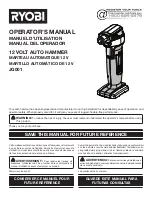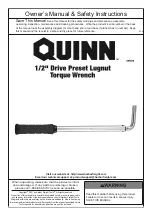
As you vacuum the kiln, examine the walls for glass or
glaze particles that have embedded into the firebricks.
Dig these out carefully with a screwdriver. Otherwise the
particles will embed deeper into the firebrick during the
next firing.
How to Use Kiln Wash
Pour a little water into a disposable container and
add powdered kiln wash until it has the consis-
tency of coffee cream. Stir until lumps dissolve.
Use a soft paint brush to apply the kiln wash to the
shelf. Each time you dip your brush into the kiln
wash mixture, swirl the brush around the bottom
of the container. This is because the kiln wash
settles quickly. Start the brush stroke near the
center of the shelf and work toward the edges.
This is to avoid a buildup of kiln wash on the
edges.
Apply two or
three thin coats
of kiln wash
changing the di-
rection of the
brush stroke 90°
with each coat.
Let the kiln
wash dry for a
few minutes be-
tween coats. Do not apply thick coats; they tend
to flake off.
Remove any buildup of kiln wash from the edges
of the shelf by tracing around it with a finger. Ex-
cess kiln wash may break off the edges and fall
onto ware positioned below the shelf. Dry the
shelves completely before firing.
Brush kiln wash onto the kiln bottom. Protect the
kiln walls and elements from kiln wash with a
piece of cardboard. Never apply kiln wash to kiln
walls or to the underside of shelves.
Let the kiln wash dry overnight. You can speed
drying by placing shelves in the kiln and heating
to around 200°F / 93°C for an hour. The
kiln-washed shelves are still wet if they feel cool
to the touch.
Guidelines for Loading the Kiln
Disconnect the power before loading the kiln.
Keep ware at least one inch away from any heating ele-
ment. Glazes may bubble and land on an element if the
ware is too close. If you fire a piece that is so large that a tip
of it comes closer than one inch to a kiln wall, place that
section of the piece between elements and not directly
opposite an element.
The minimum spacing between shelves is 2 1/2".
Shelves must be stacked so there is at least one row of
heating elements between any two shelves.
As you load each shelf into the kiln for a glaze firing,
wipe off or vacuum dust from the underside of the shelf.
Separate glazed ware by half an inch. If they are placed too
close together, a glaze of one color may contaminate the
glaze of a different color on the next piece.
Low- and High-Fire Clay
Q
What is the difference between firing low and
high fire greenware and glaze?
A
Low-fire greenware is fired to a higher tem-
perature than the glaze firing. High-fire
greenware is fired to a lower temperature than
the glaze firing.
Do not fire plaster, plaster of paris, or polymer clay in
the kiln. They are not designed to be fired to high tem-
peratures.
Clay is usually fired twice. The first firing is the
greenware, or bisque, firing. The second is the glaze fir-
ing. The greenware firing hardens the raw clay so that it
can accept glaze.
Note:
Greenware is unfired clay. Bisque is fired
clay that has not yet gone through the glaze firing.
FIRING THE KILN
After you have loaded the kiln and positioned
cones so that you can see them through the peep-
hole, lower the lid to the vented position.
Turn the switch to the on position.
Vent the kiln at the beginning of the firing by re-
moving the peephole plug and propping the lid
with the Prop-R-Vent (see page _). Venting the
kiln allows moisture and fumes to escape. Hold a
mirror above the lid or peephole where hot air
from the kiln will move across the mirror's sur-
face. If the mirror fogs, the greenware is still re-
leasing moisture. Keep the lid propped until the
mirror no longer fogs.
Note:
If you hold the mirror too long near the kiln,
the mirror will heat up and will no longer fog
when moisture hits it. So hold it at the lid for only
several seconds at a time.
After the kiln has released the moisture, the vented pe-
riod is over. Lower the lid all the way, and close the peep-
hole.
When the cones bend to the 6 o'clock position,
turn the switch to the off position and allow the
kiln to cool to room temperature before unload-
ing.
6

























